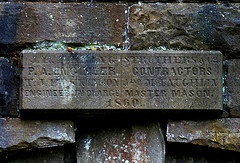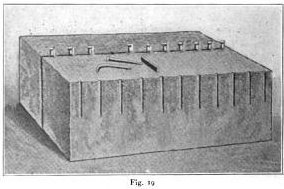
Ten years later, in 1870 in the borough of Warren, Warren County, none of the 18 stone masons are listed in the federal census, except for John McLaughlin, who was living in Corry, PA with a large family. Most were probably masons hired by the Erie Railroad and were part of the traveling railroad construction crews.

This photo shows the stone-carved Bridge Plate of the Warren County Morrison Run arch bridge. Though John McLaughlin was not listed as a Master Mason in the census, he was the Master of this wonderful construction in 1860.
The most important aspect in bridge construction was to have a master mason with a full set of quality skills at geometry, design, drafting, surveying, engineering, and the ability to manage stone mason apprentices.
James and Mary Gage, experts on stone structures in America told me, “Stone arch culvert construction generally involves three different groups of workmen. Quarrymen, who split and removed the stone from the quarry. Skilled stone carvers, who trimmed the blocks to their proper size and created the finished surfaces. Laborers, who construct the stone arch culvert under the direction of a master stone mason.”

Stone masons would drill the stone by hand, then place feathers (sleeves) in
the hole and a wedge, and then hammer the wedge until the stone split.
It would be awe-inspiring to think that maybe Irish-born John McLaughlin was the master mason in charge of the construction of the Big Shanty 1864 Arch Bridge. John may have been, knowing that he was in Warren, PA in 1860, then in Corry, PA in 1870. (Corry, only being 60 miles from Big Shanty, PA)
I should also state that J. Edward Bering, the engineer of the Morrison Run Bridge, began his professional career on the Pennsylvania Railroad in 1848, then resigned from that company to become associated with the Erie Railroad. He was credited with the construction of the first long tunnel and the “Horseshoe Curve” on the Pennsylvania Railroad.
In the census of 1860, there wasn’t a stone mason listed in Lafayette township or in the 1870 Federal census. Thus, the thinking that all of the stone construction laid on the Buffalo, Bradford, & Pittsburgh (Erie) Railroad, Big Shanty grade section was done by an Erie RR skilled traveling crew that came to Lafayette Township to work for many months.
Another story told about the 1864 Arch Culvert was that Irishmen constructed it. Well, some of the stone masons that worked on the Sunbury & Erie railroad in Warren were from Ireland. There is also a small town located in Lafayette Township called Irishtown, which is located less than a mile from Big Shanty up Big Shanty Road towards Lafayette.